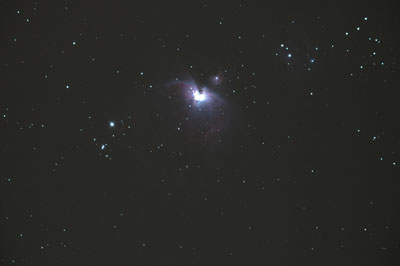Orion is the most prominent winter constellation and was known as a warrior, shepherd or giant for millennia. He was equated for example as the Egyptian god Osiris and the Sumerian King Gilgamesh. The constellation represents a broad-shouldered man. The stars δ, ζ and ε are usually referred to as belt stars. Below the belt stars are the stars of the sword, where you can see the gleam of the great Orion Nebula even with the naked eye. To the west of the constellation the stars π1 to π6 form a wide arc, Orion is thus armed with bow and arrow. In other cultures the conspicuous constellation is interpreted as a plow, butterfly or boat.
The Orion Nebula is the most conspicuous emission nebulae in the sky. It marks the active part of a star-forming region that migrates through a giant gas nebula that is more extensive than the entire constellation. The way of star formation can be tracked by the age of the stars – Rigel (β Orionis) was created twelve million years ago, the belt stars are about eight million years old and the stars of the sword originated about six million years ago. The stars near the Orion Nebula are only about two million years old.
The belt stars also mark almost exactly the celestial equator, i.e. the extension of the plane of the terrestrial equator.
α Orionis is called Beteigeuse especially in Germany because of a typo in an ancient star atlas, the spelling Betelgeuze is older and comes from the Arabic. The name means “Shoulder Star of the Giant”. The 430 light-years distant star is a red supergiant with five hundred to eight hundred times the solar diameter and ten times the solar mass. Due to its size, it is not stable – with a period of about 2,300 days the diameter and its brightness change. Betelgeuse is 0.4 to 1.3m bright, but because of a lack of suitable comparison stars it can be difficult to create a light curve. The star is a little closer to us than the younger stars of the Orion association, but it is not clear whether it arose very early or completely independent of the younger stars formed.
The 770 light-years distant β Orionis (Rigel) is at 0.3m the seventh brightest star in the sky. If this 12 million year old giant would be only as far away as Sirius, it would shine at -10m, or a fifth of the brightness of the full Moon.
δ Orionis is also called Mintaka (belt) and is a physical binary star. 52 seconds of arc separate the 2.2m bright main star from its 6.9m bright companion. Both stars appear pure white. The two suns are about one-third light-years away from each other and about a thousand light-years from Earth. The brighter star is also a spectroscopic binary. The system includes two other members but they are too faint for a pair of binoculars.
The Great Orion Nebula (M 42/M 43) is the prime object of the winter sky and visible to the naked eye as a nebula in Orion’s sword hanger. Nevertheless, the 15 to 30 light-years large emission nebula was described no sooner than in 1611 for the first time. It is the brightest area of a giant nebula complex, which extends beyond the boundaries of the constellation Orion. The nebula is an active star-forming region and its fluorescing shine is excited by young, hot stars. The recent star formation began 100,000 years ago and can be proven only by its infrared radiation. The stars that we see embedded in the nebula today were created about a million years ago. Their most conspicuous representative is θ Orionis, the Trapezium. You need 12x or so magnification to resolve it into four stars.
M 42 is the larger, brighter part of the nebula. M 43 is smaller and roundish, it is usually not perceived as a separate nebula. The visible area of the Orion Nebula is 1,300 to 1,900 light-years away and still contains enough material to form 10,000 stars with the size of our Sun. The nebula itself is very thin.

M 78 is only an eight minutes of arc large reflection nebula surrounding a 9m bright double star. It is reminiscent of a faint comet with two cores. At least in a 10 × 50 binocular it can be spotted under good conditions quite well and thus is one of the few reflection nebulae which are within the reach of binoculars. It lies 2.5° north of ζ Orionis and a little more than 3.5° east of δ Orionis. The northern edge of the nebula appears sharply defined, while the south is irregular and slowly fading away.
Collinder 65 is a large cluster of stars between the sixth and eighth size with a diameter of 2°, which lies on the border of Taurus – its members are located on both sides of the constellation border. Due to its large extent it is more reminiscent of a rich star field than a star cluster and an ideal object for binoculars.
Collinder 69 extends around λ Orionis. About 20 stars of this 1,600 light-years distant star cluster are visible in binoculars. It has a diameter of about 1°.
Collinder 70 includes the belt stars of Orion, so that it is easy to find. However, it is difficult to decide which stars still belong to the 3° large star cluster and which don‘t. Overall, it contains about 100 stars that are brighter than 10m.
